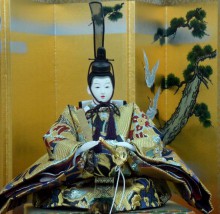An exhibit of Japanese ritual Hinamatsuri dolls has been opened in Chernihiv. This unusual exposition is staged at the Collegium of the National Architectural and Historical Preserve of Ancient Chernihiv, while the dolls have been provided by courtesy of the Japanese-Ukrainian Cultural Center. The exhibit also displays Japanese family emblems. Visitors can see miniature replicas of the Buddhist monasteries and sanctuaries of Japan, which are on the list of UNESCO World Heritage Sites.
Dolls are central to this uncommon exposition which experts have already dubbed “Japanese spring.” Admittedly, nowhere else in the world are there so many dolls as in Japan. So this state is called, not without reason, the “Country of 10,000 Dolls.”
According to Tetiana Mykolaiko, an Ancient Chernihiv research associate, the Japanese tradition to display dolls dates back to the 17th century: there were five daughters in the family of a rich shogun, and, to please them, he commissioned a master to make a tiered platform with dolls, which imitated the imperial court. In the course of time, displaying dolls also became a vogue tradition in poorer families.
“We displayed a Japanese platform with dolls for just one day, on March 3, Girls Day or Peach Blossom Day,” Mykolaiko says. “For the Japanese consider the peach a symbol of tenderness and femininity. This kind of dolls were not to play with but only to feast your eyes on. Both mother and daughter were preparing for the feast. After the feast, the girl was to properly wrap all the dolls and carefully put them into special boxes. It was believed that if a girl could not collect the dolls properly, she ran the risk of staying unmarried.”
Japanese boys also had dolls of their own. May 5 is considered their day. “A small platform was displayed on Boys Day,” Mykolaiko explains. “It could be just a table with a samurai’s gear, weapons, a horse, a lion – that is, the things that symbolize the courage and bravery of a future samurai.”
What creates the atmosphere of a faraway and mysterious Japan are family emblems – little pictures of different content embedded into an imaginary circle, while hieroglyphs will help rouse the fantasy of visitors.







